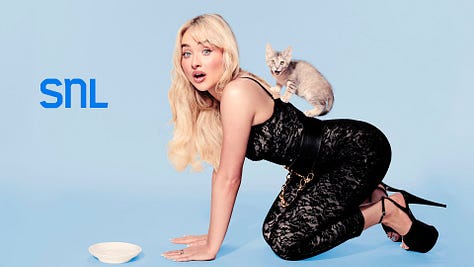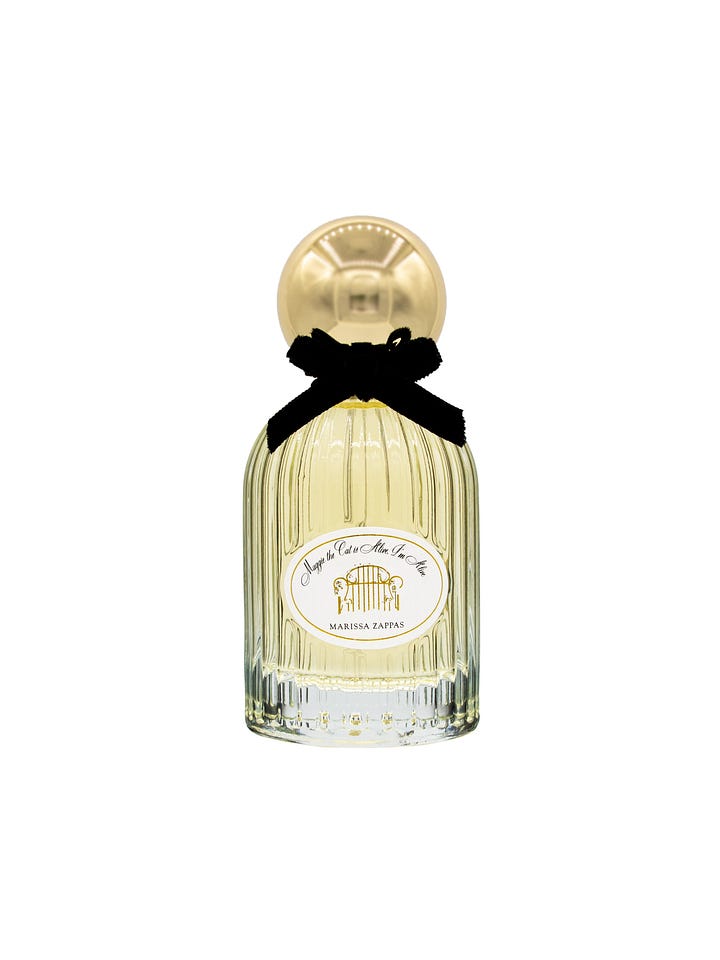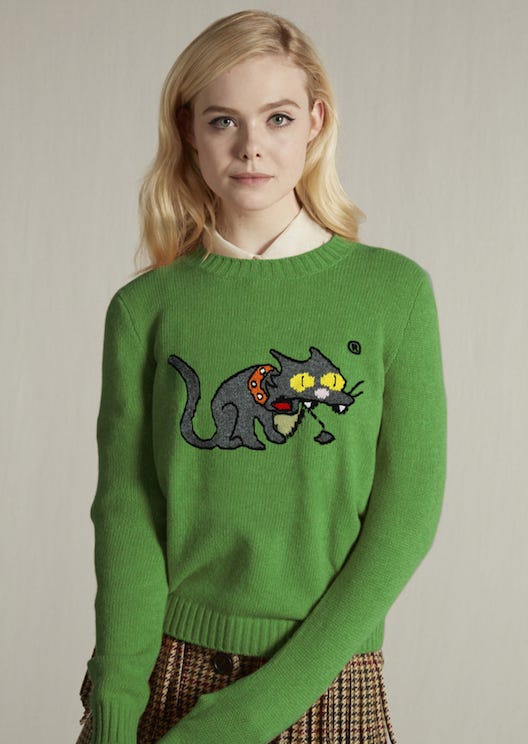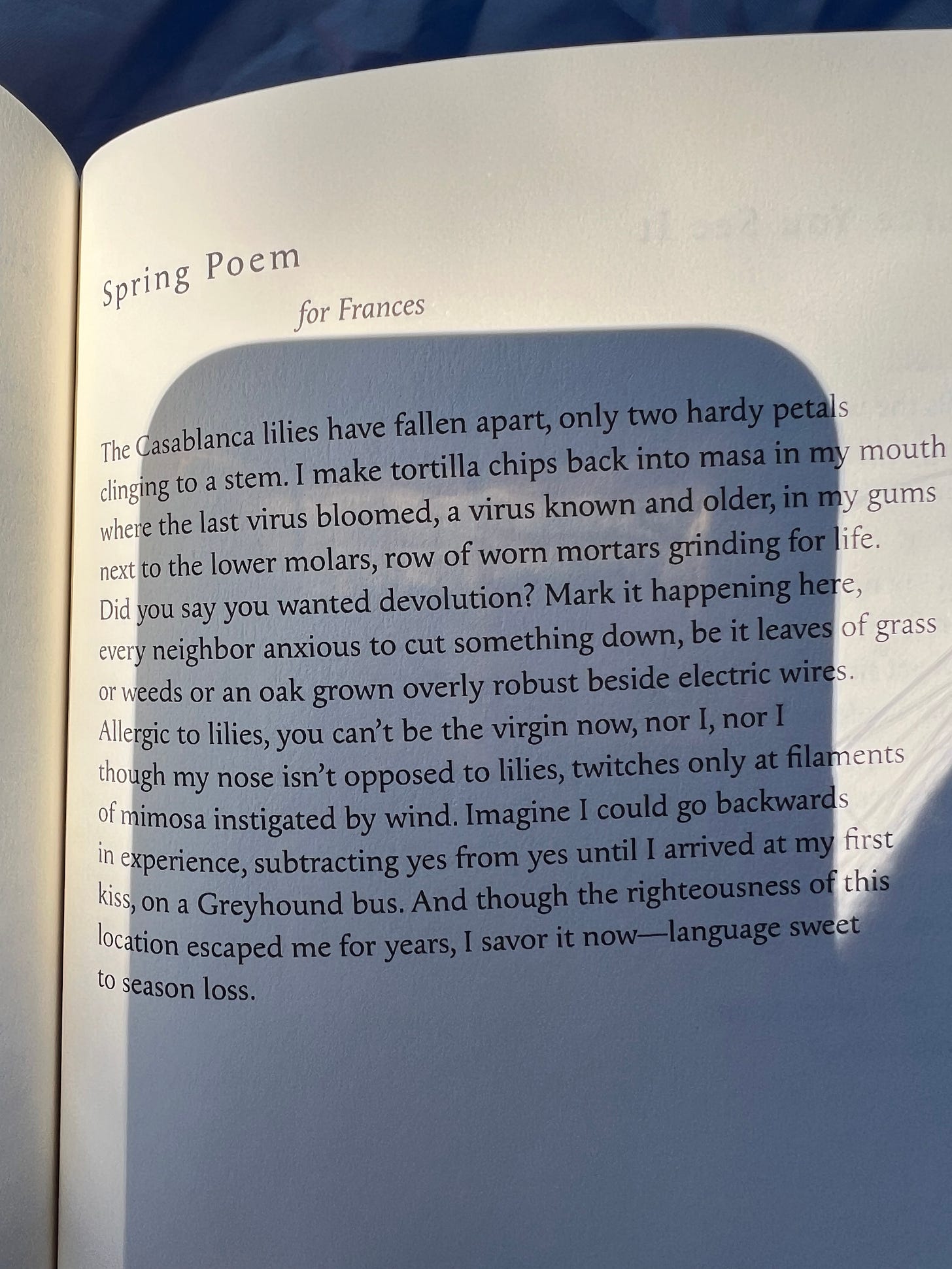Warning: this post contains a delightfully obscene amount of cat and cat-related content.
Riddle: what is brat? There are many right answers to this question but perhaps none more right than cat. Cat is brat.
Today is August 8 and that, as I learned courtesy of the internet—where cats being cats rule more eyeballs than almost anything else—is International Cat Day.
Before we get into it, a few quick updates from me: It’s my first in my new home and one of my favourite things to do is going on walks because as it turns out, I’ve moved to cat city. I’m working on a project I’ve been wanting to launch for over a year now. And the world, is as usual, a clown show (which is to say, scary and funny and delightful and terrifying and outlandish), no example more pertinent now than the lead-up to the U.S. presidential election. (Know where I’m going with this?)
You may have heard Republican Vice President nominee JD Vance’s comments on “childless cat ladies”. Since then, he clarified his statement: oh, he has nothing against cats. (And then his wife: oh, he has nothing against women who can’t have children, just women who don’t want children.)
Because that would just be a crass thing to say considering how popular cats are, from their status as the internet’s mascot to their cinematic takeover to their possibilities in the multiverse. See: The Marvels in which onscreen chaos ensues thanks to cat-like alien creatures called Flerkens; Exploding Kittens, the webcomic turned indie card game that played their cards right and is now a Netflix animated show; and Stray, the major hit video game published by the billionaire-backed media company Annapurna, in which you play as a stray cat in the future, now being adapted into a film (not to be confused with 2023’s Strays).
Welcome to Expansion Pack #2, Cat Lady. If this is you, consider this a tribute. If not, well you already had the pleasure of partaking in the masculine ideal of renegade via Cowboy, so it’s only fair that you get to know its feminine counterpart.

But a cowboy is nothing like a cat lady, you say. No, of course not. That’s thanks to a funny little thing called a double standard. Because why else would cowboys be exalted as cool and cat ladies as crazy when they have so much in common? Both on the fringes of society yet one accepted as icon and the other as castaway?
Let’s get into the cat (lady) pack.
First we meet the cat lady as pop star, a relatively new phenomena that came in a wave within the last year. And they’re all blondes—even if temporarily, as is the case for Lana. Blondes have more fun, cats are more fun than no cats. Makes sense. It’s as if SNL, Skims, and TIME Magazine all had the same idea in different flavours.



But before the 2023/2024 pop star x cat takeover, cats were known to be associated with another iconic female figure: the witch.
Cats as demonic aids are, like many cultural beliefs, rooted in religion and its quest for power, specifically the rise of Christianity and the denouncement and erasure of other faiths. The logic: since many (if not most) other religions in the world worship cats, and they are the wrong religion, cats = the devil. It probably didn’t help that the way cats play with their prey seemed wicked.
“Wicked” is a term usually applied to witches. Language lesson: wicked comes from the word Wicca, which is an Old English word for Wizard. Wicca is also the root word for witch. But somehow, wizard = male/good, witch = female/bad. Dogs = man’s best friend, cats = witch’s familiar. Notice a pattern? Let’s hold this thought with a poem by Ada Limón.
I recently watched A Quiet Place Day One starring Lupita Nyong’o as a terminally ill poet at ground zero of an alien invasion. (Yes, poet! I can’t remember the last time poet was treated as an actual occupation in a film.) In it, her character, Sam, has a cat, Frodo. Lupita said in interviews that she had a fear of cats and even asked the cat to be swapped out for a different animal. Her suggestion was an armadillo. Suffice to say, that didn’t happen and Lupita had to go through cat therapy before filming.
Most cats in movies belong to women or exist as (bad) omens. But in another sleeper summer hit, Hit Man, Mr. Booked-and-busy Glen Powell as a “you drive a Civic” college professor is a cat man / cat lord, or cat person, whichever is the equivalent of cat lady.
Cat Person is also the title of a 2017 short story by Kristen Roupenian in the New Yorker that went viral (one of the very few cases a short story has ever gone viral and probably one of the only short stories many people have actually read outside of school). It was adapted into the 2023 psychological thriller of the same name, which didn’t actually have a lot of cats (IFKYK), and was more about dating and red flags and being a 20-something woman.
But I don’t have to go far to find movies with cats or famous cats in movies (Puss, Garfield, Bigglesworth, Black Cat), and in the case of Cats, people dressed as cats. In 2019, a film adaptation of the broadway hit Cats came out and was critically panned. The broadway show, though, is a long-standing verifiable hit; it was the first blockbuster musical. And it’s based on a poetry collection by T.S. Elliot, called Old Possum’s Book of Practical Cats. Yes, the same T.S. Elliot who wrote The Waste Land, the poem Oppenheimer was reading in the film about becoming destroyer of worlds, is the same guy who wrote this collection of whimsical cat poems.
My own current collection of cat-themed literature includes:
A magazine: Catnip, A Magazine for Cat People (purchased online here), so good it’s practically a fashion magazine complete with cat horoscopes and really interesting photography
Some non-fiction: Cats’ Paws and Catapults: Mechanical Worlds of Nature and People by Steven Vogel (purchased at The Last Bookstore in LA) and Kaibyo: The Supernatural Cats of Japan by Zack Davisson (purchased in a bookstore in London, UK)
Fiction: The Guest Cat by poet Takashi Hiraide (Tip: Cat-themed literature is practically its own subgenre of fiction in Japanese literature.)
The perfect coffee table book: The Cat Made Me Buy It! (purchased at Value Village in Vancouver), an entire book showcasing vintage advertisements featuring cats, like this one by Coca Cola:
And a poetry collection: Cat’s Tongue by Kathleen Winter (purchased at AWP in Kansas City, Missouri)
Here’s another cat lady poem, Self-Portrait as Wounded Doe of Artemis by Aria Aber (full text here in The Rumpus):
Fur and itch— under my dress of rods I’m armored, hot and ready to pierce into Zeus—but he has lonelied this city now, so I perforate his trembling cats, the elders. Stop me. Split me. Yes, once I was frail with holy, a handful of pistachio shells breaking under my heel—now I’m too much to handle, a rocking sound, an un-wine-dark pooling around me.
And (so far) the ultimate cat lady poem of all cat lady poems, Ella Mason and Her Eleven Cats by Sylvia Plath:
Old Ella Mason keeps cats, eleven at last count, In her ramshackle house off Somerset Terrace; People make queries On seeing our neighbor's cat-haunt, Saying: ‘Something's addled in a woman who accommodates That many cats.’ Rum and red-faced as a water-melon, her voice Long gone to wheeze and seed, Ella Mason For no good reason Plays hostess to Tabby, Tom and increase, With cream and chicken-gut feasting the palates Of finical cats. Village stories go that in olden days Ella flounced about, minx-thin and haughty, A fashionable beauty, Slaying the dandies with her emerald eyes; Now, run to fat, she's a spinster whose door shuts On all but cats. Once we children sneaked over to spy Miss Mason Napping in her kitchen paved with saucers. On antimacassars Table-top, cupboard shelf, cats lounged brazen, One gruff-timbred purr rolling from furred throats: Such stentorian cats! With poke and giggle, ready to skedaddle, We peered agog through the cobwebbed door Straight into yellow glare Of guardian cats crouched round their idol, While Ella drowsed whiskered with sleek face, sly wits: Sphinx-queen of cats. ‘Look! there she goes, Cat-Lady Mason!’ We snickered as she shambled down Somerset Terrace To market for her dearies, More mammoth and blowsy with every season; ‘Miss Ella's got loony from keeping in cahoots With eleven cats.’ But now turned kinder with time, we mark Miss Mason Blinking green-eyed and solitary At girls who marry— Demure ones, lithe ones, needing no lesson That vain jades sulk single down bridal nights, Accurst as wild-cats.
Jumping from poetry to perfume:




YSL’s Babycat sounds like a cat but doesn’t smell like a cat.
For that kitten fur smell, there’s Demeter Kitten Fur.
Indie perfume brand Stereoplasm did an entire collection called “Let the Cat Out of the Bag” back in 2020 featuring 9 fragrances including Yelling Cat, Soft Cat, Ballroom Cat, and Snoozy Cat.
Patiently waiting for Toronto brand Zoologist to release a Cat fragrance. Does Tiger count?
But that’s cats. What about cat ladies?
Jewelry brand Catbird’s signature candle is Kitten, “with visions of dusty records, lipstick, and feather pillows and notes of musk, amber & hand-picked violets. A love letter to the early girls of Catbird, the Williamsburg kitten with her affinity for busted tees, ballet flats and jewels, sneaking a cigarette out of her apartment window (she's since quit)”.
Perfumer and poet Marissa Zappas (who is hosting a “sensorial reading” in NYC on August 21 along with poet Ariana Reines, among others) has a fragrance called Maggie the Cat is Alive, I’m Alive!, after the line from the 1958 film, Cat on the Hot Tin Roof starring Elizabeth Taylor. It doesn’t smell like cats but actually kind of like the idea of a cat lady, so says reviews I’ve read. Actual text: “like a cat lady’s house”, which is apparently like hairspray and animal fur and ashtray. Here are the notes: Champagne, Ambrette Musk, Peach, Oakmoss, Violet, Orris, Sheer Amber, Castoreum, Patchouli, Sunlight and Sandalwood. Sounds like a fancy cat. Related reading: Whitney Mallett’s review of this perfume for The Paris Review.
When it comes to fashion, you might not be able to get your hands on one of Kelsey Reese’s upcycled cat blankets turned dresses. And in that case, the cat lady brand has to be Miu Miu, though the irony given the cat lady stereotype of an older, childless woman is that Miu Miu is known as the younger, more playful sister brand to Prada. See: this campaign video featuring a kitty for L’eau Bleue, and the Famous Cats collection in 2018 (sweaters) and then again in 2021 (t-shirts).


Miu Miu is currently an anomaly in the luxury fashion market; where sales have been mostly down for most other brands, they’ve just reported 93% growth in the first half of the year, up from 2023. As it turns out, Miu Miu is popular with Gen Z, the first generation to grow up completely digitally native in a land where cats rule. Could we be making a transition from cat ladies to cat girls, from a symbol of spinsterhood to girlhood?
Dazed editor Claire Marie Healy wrote about Film’s Obsession With Cats and Teenage Girls, an article which observes the link between cats and girlhood through the lens of the critically acclaimed 2018 film Madeline’s Madeline.
She writes:
…‘cat’ comes from ‘cattere’ – to see, to observe. Like Sharna Osborne’s cat that watched over the girl-models at Miu Miu, we associate cats with what they see as much as what they do. They seem to contemplate us, to know something we don’t – maybe that’s why Ancient Egyptians held them aloft as all-knowing deities.
Cats, then, more than stand-ins for “crazy” feel more like metaphors for interiority. I wrote briefly about Marie Antoinette in my last post and discovered this fun fact: legend has it that all Maine Coons are descended from six cats that Marie Antoinette owned and managed to escape to America on a boat during the French Revolution. Sofia Coppola, who directed the film Marie Antoinette, is known for her depictions of girlhood, and specifically, what she has done to strike a nerve is her attention to detail and to the interior lives of those who typically weren’t shown to have them.
It seems silly now, given everything that I know about cats, that I didn’t always like them. I wasn’t always a cat lady, both in the literal sense of being a lady who has and loves cats and in the archetypal sense of being a unmarried (technically divorced, as forms apparently need to know) childless/free woman of a certain age, who is also introverted and has no limit other than condo strata rules of the number of cats I could have.
The trope of the cat lady and its various incarnations across cultures, have been pounded into me since I was a little girl. But in the grand scheme of my life, cats are new to me. I went from cat-neutral to cat-lover.
So today, when I think about the malleability of human beings, I always think about cats. I think about how often we make declarations about who we are before we know, and about how often we let others tell us, how whether we like it or not, whether we even believe it or not, we let their opinions shape us, their validation and approval define us.
What is it about cats that have so strongly attached themselves to the idea of an independent woman? Sure, there’s the whole association with witches thing, but beyond that, once you’ve had a cat, as I’ve discovered, you start to get it.
Cats have the label of “pet” but they pretty much domesticated themselves for their benefit, the only animal to do so. They didn’t change anything about themselves to live with humans. They don’t think or behave as if you own them and will pretty much just do whatever they want. Which I get it, sounds like a nightmare for some people. They also do this funny thing called “cat-culating”, in which you can literally see the gears in their brains moving as they judge their next move and often succeed with Simone Biles-like precision.
Cat-culating, of course, comes from calculating. We’ve heard this word before, often applied to women who think and act strategically, i.e. with thought and intent. We most often hear it as derogatory because it goes against our picture of the ideal woman or girl, someone who is compliant, nice, Cool. (Amy, as we know, is the ultimate calculating woman to its murderous extremes, hiding behind a visage of Cool Girl. Also, I rewatched Gone Girl and realized I’d somehow completely missed the presence of a cat the first time.) We hear it so much, both in public discourse and in our own inner monologues, when it comes to powerful, ambitious women and women who show a trajectory or inclination (or let’s be honest, a tiny whisper) towards power or ambition, even if it’s towards the power and ambition to be oneself.
It doesn’t surprise me at all that the woman the whole world is watching right now, Presidential nominee Kamala Harris, is at the centre of a soundbite around childless cat ladies. Or that Taylor Swift is dragged into the conversation as one of the world’s most powerful people. It’s the lowest common denominator insult hardly any woman is immune to.
Our primary value as a society for women is childbearing or youth. Neither? You’re a cat lady. Being a cat lady associates the independence many of us desire and work so hard for with undesirability. When aging already provides us all the physical signs of loss, tropes like this amplify the emotional loss of the short blip in time women are allowed to be independent people. It happened to me. I only felt like I had recently started to enjoy my adulthood before I felt the pressure, like age had finally settled in and I was meant to take my place. My timeline to decide very important life decisions felt, similarly, like a blip. And then I was over the hill. Youth is relative, sure, but it’s always the relative prize.
I woke up a couple mornings ago to Ask Polly’s advice to a young letter-writer, newly graduated, who wanted to know: “Why Did No One Tell Me That Life Was So Limited?” I think a lot of people feel this way, not just women. But I think that this feeling can come suddenly and overwhelmingly for women especially, and for many, regardless of whether or not you’re a mother, there is grief of a life lost somewhere. I’m at the age where everyone I know has now made their choice, and whatever that is, the road is clearly diverging, identities and futures seemingly locked in.
“Cat lady” is like cowboy but not really like it at all. Call someone a cowboy and they’re probably loving it to the same degree as flying to space (because remember, cowboys and spacemen are two sides of the same frontier). Call them a cat lady and yes, cats are great and cute and almighty even, but there’s a feeling of being further reduced to the sidelines when women have already been sidelined throughout most of history. Invalidation is the punishment for choosing to take the road less taken.
Add “crazy” and there’s no better than example than Eleanor Abernathy from The Simpsons, THE “Crazy Cat Lady”, the very first cat lady my cultural consciousness was exposed to. Eleanor once had dreams of being both a doctor and lawyer, having attended both Harvard and Yale Universities. In the show, she’s portrayed as an elderly woman but here’s the kicker: she’s only 40 years old.
Susan Sontag writes in On Women:
Far more extensive than the hard sense of loss suffered during menopause (which, with increased longevity, tends to arrive later and later) is the depression about aging, which may not be set off by any real event in a woman's life, but is a recurrent state of "possession" of her imagination, ordained by society-that is, ordained by the way this society limits how women feel free to imagine themselves.
…almost all women endure some version of this suffering: a recurrent seizure of the imagination that usually begins quite young, in which they project themselves into a calculation of loss.
It only helped when I stopped seeing what I was losing, and instead what I could gain.
Women have another option. They can aspire to be wise, not merely nice; to be competent, not merely help-ful; to be strong, not merely graceful; to be ambitious for themselves, not merely for themselves in relation to men and children. They can let themselves age naturally and without embarrassment, actively protesting and disobeying the conventions that stem from this society's double standard about aging. Instead of being girls, girls as long as possible, who then age humiliatingly into middle-aged women and then obscenely into old women, they can become women much earlier-and remain active adults, enjoying the long, erotic career of which women are caPablo, far longer. Women should allow their faces to show the lives they have lived.
And:
Any serious program for liberating women must start from the premise that liberation is not just about equality (the "liberal" idea). It is about power.
These excerpts were written in the early 1970s. We’re fifty years out and still trying because clearly, equality in the eyes of the law is not enough when we still give others the power to decide and shape our lives. Unlike cats, we only have one.
So let’s call it what it is: cat lady summer. The summer that (s)purred defiance, love, wonder, hijinks, chaos, and energy. Where we demand, not just comply. Where we dance, not just strive. It’s okay to be a bit messy, dumb puns and hapless schedules, changed minds and unanswered questions—and all of you, even if you can’t have all of it.
Should I run or become a grid.
More cat lady miscellany:
The line above is just one of many favourites from one of my top poetry collections of this year, If I Could Give You the Line by Carrie Oeding. It’s more about motherhood than about childless cat ladies, but really, it’s about the tensions of possibility and loss and art-making—relevant to all women.
Kate Bolick’s Spinster: Making A Life of One’s Own is what I consider to be essential reading for anyone who needs more examples of women operating outside of society’s norms.
Girls and Their Cats is a book and website by New York based fashion photographer BriAnne Wills.
The French novel Fresh Water For Flowers by photographer and screenwriter Valerie Perrin, about the pink silk-wearing, middle-aged caretaker of a cemetery, the kind of uniquely cinematic yet quiet story that I’ve rarely come across. Cats make an appearance.
- , a Substack newsletter that just came back after a hiatus, and features exactly what it says. Not about ladies, just about cats.
The plethora of cat lady board games and escape rooms that exist.
If you need a pep talk: this video by opera singer and TikTok creator Vanessa Aldrich (who also hosts poetry readings on Zoom, including one tonight).
The words of desire from the notes of artist Louise Bourgeois (who, for the record, had three children and at least two cats), written in 1962:
And because I started this post with blondes and their cats, it’s only fair I end with brunettes and their cats:

And my two oranges, George and Marshall.
I already broke into sincerity, and no one seemed to care. I was free to touch the art and swim in the pool.
—From “Don’t Wake Up the Paintings” by Carrie Oeding















Amazing montage and cultural deep dive, though you're missing the ever-important lesbian association with cats! (which also comes from witches, naturally.) I obvs wrote a whole book about this: The Lesbian Sex Haiku Book (with Cats) :)